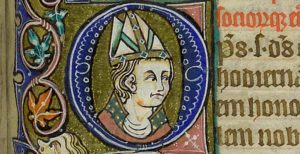
Saint Swithin, also spelled Swithun, The meaning in Old English is “strong bear cub.” He was the Anglo-Saxon bishop of Winchester. Winchester Cathedral in England and Stravanger Cathedral in Norway are both dedicated to him. His feast day in England is July 15 and in Norway it is July 2. Why Norway? His veneration may have originated with English missionaries who worked with St. Olaf in evangelizing Norway. 
Swithin was born in Winchester around 800, counseled Saxon kings Egbert and Ethelwulf, and was bishop of Winchester for the last ten years of his life. One legend claims Swithin tutored young Alfred the Great. Another says he built the first stone bridge over the river Itchen that runs through Winchester.
One of St. Swithin’s most famous miracles is a simple act of kindness. A group of workmen broke all the eggs in a poor woman’s basket as she was crossing a bridge. Swithin demanded the workmen apologize to the woman. He blessed her basket of eggs, which restored all the broken shells and runny yolks so she had whole eggs again.
His appearance to Queen Aelgifa, also known as Emma of Normandy, was another miracle. She was a half-sister to William of Normandy, later King of England. Aelgifa was the mother of Edward the Confessor, and a famous queen of England, Denmark and Norway, through her marriages to Aethelred the Uncounseled and Cnut the Great. Aelgifa was accused of adultery with Aelfwine, the former bishop of Winchester.
On the night before her “ordeal,” a trial which involved walking across white-hot ploughshares blades at Winchester Cathedral, St. Swinthin is supposed to have comforted the queen, “I am Saint Swithin whom you have invoked; fear not, the fire shall do you no hurt.” The following day the queen was able to walk barefoot across the blades and remain completely unharmed.
Swithin died of July 2, 862. On his deathbed, the bishop left instructions that his body should be buried outdoors and not in the cathedral. He wanted the rain from the eves to fall upon his grave. 100 years later Swithin’s body was removed from its simple grave and interred in the cathedral on July 15, 971. On the same day his bones were moved from the outdoors an extraordinary rainfall began. It was said his spirit was so offended by the move that it caused rain to fall for 40 consecutive days.
In 1093 his bones were moved again into a huge new cathedral built by Norman invaders. His Anglo-Saxon reliquary was carried with great ceremony to its home behind the high altar. Swithin’s tomb became a major site for pilgrims, many seeking to be healed from illness. A short tunnel (the Holy Hole) allowed them to crawl under his shrine, as close as possible to his bones and miraculous healing powers. In the middle of the night on September 21, 1538, King Henry VIII’s commissioners smashed the shrine and stole all the valuables. Three years later workmen filled in the Holy Hole. A modern memorial marks the spot where the shrine was located.
The name of Swithin is best known today for a British weather lore proverb, which says that if it rains on St. Swithin’s Day (July 15), it will rain 40 more days.
St Swithun’s day if thou dost rain. For forty days it will remain. St Swithun’s day if thou be fair. For forty days ‘twill rain nae mare
There is a scientific basis to the weather pattern behind the legend of St. Swithin’s day. Around the middle of July the jet stream settles into a pattern which holds reasonably steady until the end of August. If the jet stream lies north of the British Isles, continental high pressures is able to move it; when it lies across or south of the British Isles, Arctic air and the Atlantic weather systems dominate. 
Emblems associated with St. Swithin are rain and apples. Apple growers hope for rain on St. Swithin’s Day or St. Peter’s Day (June 29th). They see the rain as saints’ watering the orchards; or as St. Swithin blessing and christening the apples.
A verse by Anglo-American writer Elizabeth Sewell proclaims,
“High in the Heavenly Places/ I see Saint Swithin stand./ His garments smell of apples/ And rain-wet English land.”
St. Botvid could be a patron saint of good fishing luck, and/or what happens when a good intention takes a fatal turn. 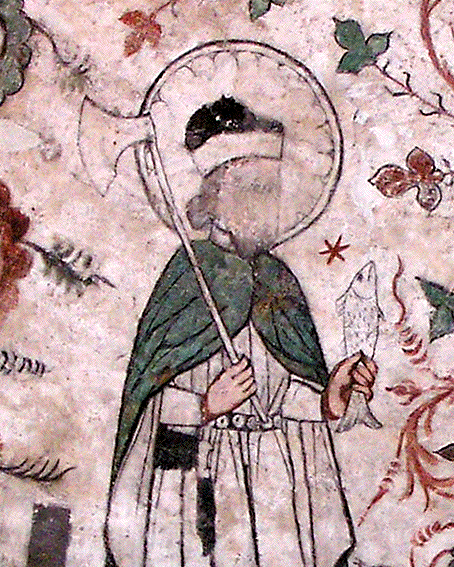
Botvid was a successful Viking or trader who encountered Christianity on a trip to England and converted during his visit. When he returned home to Sodermanland he began to evangelize in the surrounding area. The year of St. Botvid’s martyrdom was traditionally thought to have occurred in 1120 A.D. However the Swedish historian, Johannes Messenius, proposed that Botvid returned to Sweden from England in 1055 and died in 1076.
St. Botvid is usually shown holding a fish and an axe. The fish represents his “fishing luck” miracle. After Botvid returned to Sweden, he went out to fish with some neighbors. The best fishing spot was near an island owned by a man named Bo. Bo claimed one-quarter of the catch from anyone fishing his grounds. He sailed out to tell Botvid and his group when he saw their boats approaching. Knowing it was a rich fishing area, some of the people decided to stay and comply; but Botvid left and went to another spot. The fish followed him. His catch was so great that he was able to share with his neighbors and other local fishermen who went to his spot. When Bo sailed over to see what was happening Botvid invited Bo to fish for free, and his heart was won over. 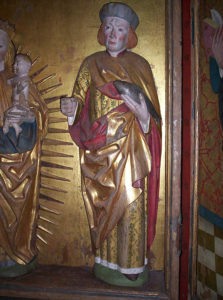
Another tale associated with St. Botvid is his encounter with a man for sale. The man was a foreigner, Wend, Finn or Slav – the stories vary. Botvid’s plan was to convert this pagan to Christianity, and then emancipate him so that he could return home to evangelize. After baptizing the slave, Botvid and one of his tenant farmers, a man named Esbjorn, set out to return him to his homeland. As they headed toward Gotland, they stopped to camp on Rago Island in Sodermanland. The new freeman took Botvid’s axe and killed both Botvid and Esbjorn in their sleep. He took the boat and sailed away.
According to legend, Botvid’s brother, Bjorn and a priest named Henrik began searching for the missing men. Guided by a white bird, they found Esbjorn’s bones and Botvid’s intact body. A well of clear water was streaming from the place where Botvid’s blood had dripped from his wounds. Botvid is associated with another spring as well. Saint Botvid’s Spring (Sankt Botvids Kalla) is located at the southeastern tip of Lake Bornsjons. The water began to flow after Botvid’s casket was set down in route to his final resting place. 
His brother, Bjorn, built a wooden church on the family land in Botvid’s honor. The miracles reported at Botvid’s grave over the next nine years led to the conversion of the local people. The original wooden church was replaced by a stone structure in 1176 A.D. It is in Botkyrka (Botvid’s Church), a town not far from Stockholm.
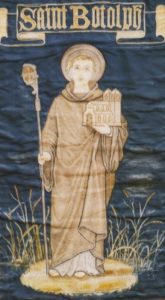
Saint Botulph (also spelled Botolph and Botwulf) was born to a noble Saxon family of Christians in 610 A.D. The boy was sent away to a monastery when Mercian forces under King Penda invaded the region. He became a Benedictine monk at Farmoutiere-en-Brie in France, under the abbess Burgundofara, also known as Saint Fara. He returned to the British Isles in 647 A.D. to establish a Benedictine monastery.
In 654 A.D., Botulph founded the Benedictine monastery of Ikanhoe (Ox Island) with the support of King Anna of East Anglia. The monastery may have even been dedicated to the king. In founding the monastery, Botulph chose a wild, barren fen reputedly haunted by demons. Ikanhoe was surrounded by water and foul-smelling marsh gasses that produced a disturbing nighttime glow. Some early accounts maintain that this was the work of ghosts and devils. Another story claims that a few degenerate descendants of an earlier race may have occupied these Suffolk marshes. These vaguely humanoid creatures are suggestive of the underground beings in Robert E. Howard’s horror story, “Worms of the Earth.” 
It was said that the evil spirits that lived at Ikanhoe were disturbed at Botulph’s arrival. They had dwelt there a long time, they said, and thought that they would do so forever. They had no other place to go. Couldn’t he seek another spot? They felt that the saint was acting unkindly by disturbing them. Botulph didn’t listen to them. The monks built several structures and drained the marshlands. The marsh grass with its “night glow” disappeared. Botulph became revered for his ability to expel bogs of their “devils.” He died on June 17, 680 A.D. after a long illness.
Although many early accounts testify to the existence of Saint Botulph, no one is sure exactly where his monastery was built, since the saint was a traveling missionary in rough bandit and demon-plagued areas. Some think it was at Boston (a shortened form of “Botulph’s Stone”) in Lincolnshire, the home of Saint Botulph’s Church, also known as “The Stump.” The other possibility is Iken, a town in Suffolk. The church there is also dedicated to Saint Botulph. After his death his bones were moved around to protect them from raiders, and as a source of protection for local people against marsh monsters. 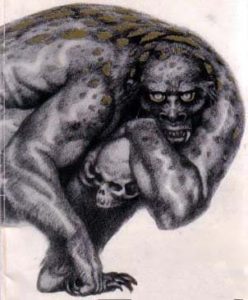
Saint Botulph’s association with hauntings and demons continued after his death. St. Botolph’s Church in Burgh sits on a small mound, suggesting ancient fortifications or burial. The mound had a reputation as the home of a water-loving demon. The nearby town of Grundisburgh may relate to the Anglo-Saxon word, “Grendel,” the fen-dwelling monster of Beowulf. Botulph’s bones were brought to Burgh to exorcise the water demon.
St. Botolph’s Church, Skidbrooke, in the Lincolnshire marshlands, is reputed to be haunted as well. Dating from the early 13th century, it is nicknamed “the demon church” because of all the paranormal activity associated with it. Visitors reported seeing a spectral monk, a headless knight, odd lights, and hearing storm sounds in calm weather. Demons are associated with a specific tomb, which it is said to be an entrance to “dimensional changes.” 
Unfortunately Saint Botulph’s bones were lost during the Dissolution, so he can’t help rid the site of spirits and Satanists. A church grim—a ghost dog guardian–would be helpful, but none are associated with the site.
Saint Winifred (or Winefride, Welsh: Gwenffrewi) was a Welsh martyr in the 7th century. The spring associated with her martyrdom and restoration is now a shrine. It is called St Winefride’s Well in Holywell, Flintshire, Wales. It is the oldest active pilgrimage site in Britain. The well is open most days of the year and people still go there to bathe and sit on St. Beuno’s stone to ask for favors and blessings. There is a tradition that before he left Holywell, Beuno seated himself on the stone and declared: “Whosoever on that spot should thrice ask for a benefit from God in the name of St. Winifred would obtain the grace he asked if it was for the good of his soul.” 
According to legend, Winifred’s family were descendants of Vortigern, a 5th century warlord. Her mother’s name was Wenlo, and she was a sister of Saint Beuno. Her father, Tyfid ap Eiludd, was the lord of Tegeingl, an area in northeast Wales which later became part of the county of Flintshire.
At the time of her martyrdom, Winifred was a teenage girl preparing to enter religious life. Her uncle, Beuno, was an abbot and her mentor. A local noble by the name of Caradoc approached her to propose marriage. Winifred was not interested in the man’s advances and refused to lay with him. She became frightened and ran to the church where her uncle was saying Mass. The rejected and angry Caradoc followed and caught up with her on the slope of a hill. He drew his sword and cut off her head. The head rolled down the slope and eventually came to rest. As soon as it stopped, a spring of water bubbled up out of the ground.
On hearing of the terrible murder, Beuno left the church and went to the newly formed spring where Winifred’s head lay. He returned the head to the body and covered it with his cloak. After Mass he returned to the body and prayed. Legend says Winifred sat up as if she had been in a deep sleep, with only a thin scar to show where she had been decapitated. 
Seeing Caradoc leaning on his sword with an insolent and defiant air, Beuno called on God to punish him. According to one legend, he died on the spot. Another legend said the ground opened to swallow him. Some historians think he was killed by Winifred’s brother, Owain.
Fearing the encroaching Saxons, Winifred and her companions left Holywell and joined a community of nuns living in Gwytherin near the River Elwy. Winifred eventually became abbess and passed away on November 3 sometime between 650 to 660 A.D.
The oak reliquary of St. Winifred was identified in 1991 from earlier drawings and descriptions. The reliquary probably contained a piece of clothing or article identified with the saint but not her bones. It provides evidence that Winifred was recognized as a saint soon after her death.
The details of St. Winifred’s life are found in two manuscripts. The one in the British Museum is by a monk named Elerius, a contemporary of Winifred. The other manuscript in the Bodleian Library at Oxford is generally believed to have been compiled in 1130 A.D. by Robert, prior of Shrewsbury Abbey. Prior Robert promoted the cult of St. Winifred. In 1138 A.D. her bones were carried with great ceremony from Gwytherin to Shrewsbury. Shrewsbury where they became an extremely popular destination for pilgrims. To further enhance the prestige of the abbey, Abbott Nicholas Stevens built a new shrine for St. Winifred, and had some of his monks steal relics of St. Beuno to add to the abbey church. They abbey was fined, but they were told that they could keep the relics. 
Many royal pilgrims have visited St. Winifred’s Well over the centuries. The earliest recorded visit was by Richard I (King Richard the Lionheart) in 1189. King Henry V made the pilgrimage in 1415 before his victory at Agincourt. In 1416, he went on foot from Shrewsbury Abbey to Holywell as an act of reverence for his victory. In 1461, the future King Edward IV of England went on pilgrimage shortly before the Battle of Towton. According to an account by Welsh poet Tudur Aled, the young king took earth from beside the well and placed it upon his crown. The future Henry VII is thought to have made a secret visit before winning his crown at Bosworth in 1485.
St. Winifred or St. Winifred’s Well have found their way into poems, plays and novels. St. Winifred’s Well is mentioned in the medieval poem, Sir Gawain and the Green Knight. William Rowley’s 17th century comedy, A Shoemaker, A Gentleman dramatizes St. Winifred’s story. Poet Gerard Manley Hopkins memorialized St. Winifred in his unfinished drama, St. Winifred’s Well. 
The most famous references to St. Winifred are in Ellis Peter’s Brother Cadfael mysteries. The story of Winifred’s relics being taken to Shrewsbury Abbey forms the basis of the novel, A Morbid Taste for Bones, the first in her series of Cadfael books. The celebration of her feast day provides the setting for The Rose Rent and The Pilgrim of Hate. The casket containing her relics is stolen from the shrine in The Holy Thief. Brother Cadfael, a Welsh monk at Shrewsbury Abbey is also a former knight and crusader. He has a special affinity with St. Winifred, who he affectionately calls “The Girl.” 
St. Wistan, also known as Saint Wystan and Saint Wigstan, died in 840 A.D. His grandfather, King Wiglaf, ruled Mercia from 827 to 839. His father, Wigmund, died of dysentery shortly before him. A young Wistan may have been proclaimed king, but more likely he abdicated in favor of King Beorhtwulf (Bright Wolf), who ruled from 840 to 852. Wistan appointed his mother, Aelfaed, as regent. Wistan’s godfather, Beorhtric, son of King Beorhtwulf was appointed as her advisor. 
Wistan was scalped and slain with a blow to the head because he protested his widowed mother’s marriage to his godfather, Beorhtric. In canon law at that time, baptism established a link of spiritual consanguinity between the parents and godparents of the baptized. As a spiritually close relative, Wistan’s godfather was forbidden from marrying her.
Aelfaed was the daughter of King Ceolwulf of Mercia who ruled from 821-823, the last of an ancient Mercian royal line descended from Offa, a legendary warrior and ruler. The prestige of marriage to woman descended from the last branch of ancient Mercia was reason for Wistan’s murder. His death resulted from a Mercian power struggle between his family and that of his uncle Beorhtwulf and his son, Beorhtric. They may have inherited claims to the Midland kingdom from an earlier Mercian king, Beornwulf (823-825) or Beornred, who was deposed by Offa in 757.
There are various accounts of Wistan’s death on June 1, 840. Beorhtric cut off his head while he was standing in prayer. Beorhtric cut off the upper part of his head with is sword, while a companion stabbed him. Beorhtric struck Wistan on the head with the shaft of his dagger while his servant ran him through with a sword. Wistan’s companions were killed as well.
Most writers identify this spot with the village of Wistow in Leicestershire, although another candidate is Wistanstow in Shropshire. According to legend, the true site of Wistan’s murder was identified by a miraculous shaft of light, and an annual crop of human hair on the anniversary of his death. 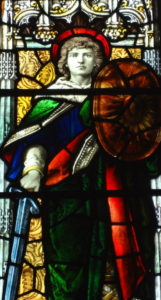
Miracles from heaven were not wanting in testimony of his martyrdom; for a column of light shot up to heaven from the spot where the innocent saint was murdered, and remained visible to the inhabitants of that place for 30 days. — Florence of Worcester
In 1077, Walter of Cerisy, the first Norman abbot of Evesham, subjected Wistan’s relics to the ordeal by fire. He was skeptical about the authenticity of Anglo-Saxon saints and relics. Since the fire had no effect on Wistan’s bones, the abbot decided to return St. Winstan’s relics to the shrine. By accident he dropped the saint’s head on the ground. It began to sweat and spread a sweet fragrance throughout the church.
The legend of the murder anniversary “crop of human hair” persisted for several hundred years. The miracle was apparently verified by a special commission set up by Archbishop Baldwin of Canterbury in 1187. 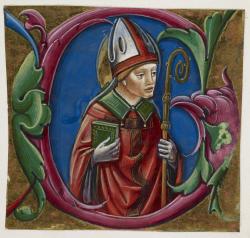
St. Wistan’s relics disappeared during the Dissolution of the Monasteries under King Henry VIII between 1536-1541.
A detailed article about St. Wistan can be found on Clas Merdin, a good source for Arthurian legends.



















